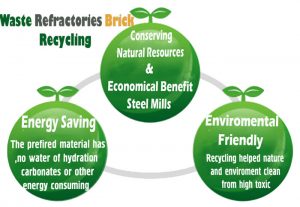Recycling of Waste Refractory Material

Waste Refractories Brick Recycling Benefits
The disposal of waste refractory material has become a major big issues for metals producers, waste management organization and association of Iranian recycling Industries. As the disposal of this type of waste materials without valuable approaches may causes the health issues, social and underground-ground water serious problems. The main issue surrounding refractory disposal is the elimination of the hazardous components of refractories, most commonly chrome-bearing material and fluoride and cyanide in steel furnace and spent pot-liners. Sarmad Shamim has started with aid of local expertise and use of various valuable approaches to prevent waste refractories pollution. Particularly company has presented itself with machinery to eliminate or significant reduction in any type of Industrial wastes.
Design For Zero Waste ( Reduction / Elimination )
In developed and advanced countries waste refractory recycling has been taken by vary approaches in many years and these companies are very Welcomed, Appreciated and Valued thru this countries.
Sarmad Shamim Sepahan co with 15 years’ experience of recycling in any type of material and along with abundant efforts in the field recycling refractory materials and the direct relationship with major domestic industry (industries that refractories materials used in Steel furnace, Pits, spent potliner “SPL”).Sarmad shamim has managed with help of local expertise to recover all the brick refractories from Steel furnace (Pits) during maintenances and devastation. Alternatively, all the bricks load into the trucks (trailer) with instance care then all the bricks will be sent it off to Sarmad Shamim warehouses. On-site of the company warehouse and workshop with aid of workforces and recycling machines separate and clean all the bricks and re-used in the refractory industry, Steel Manufacturer notably, back to the cycle action.
Typically, refractory materials for pyro-metallurgical operations are composed of MgO, Al2O3,, CaO and other stable, high melting temperature oxides. In addition to these matrix materials, other components are added to alter the refractories physical or chemical properties. These additives include graphite, tar and pitch resin, chromite ore, and various silicates among many others. Together there are over 10,000 refractory products available for use in the metals, glass, chemical and petroleum industries. The iron and steel manufacturers consume about 50 percent of the refractories while the non-ferrous sector uses another 7 to 8 percent.
Currently, Sarmad Shamim has virtually started to dispose all of the waste refractory materials that use during metallurgical in landfill sites. The main environmental issues regarding the disposal of pyro-metallurgical refractories concern chromite as well as any other materials which inevitably infiltrate into the brick during operation. Chromium is the target of stringent government regulation due to the highly toxic nature of hexavalent chromium (Cr6+ or CrO3). Although the chromium contained in refractories is associated with complex, stable, solid oxide solutions and is likely to leach into groundwater, regulations stipulate that these materials must be disposed of in a hazardous landfill site. The costs of this disposal are rapidly increasing due to the difficulty in opening new sites and anxiety over future liabilities. The primary environmental issue regarding landfilled refractories is the materials that are entrained from the operation. For example, a refractory brick employed in a copper smelter will contain various sulphides, arsenic and selenium among many others. An additional environmental issue with refractories involves the high energy consumption required for their manufacture whereas, with value approach of recycling of this bricks from lining furnaces and back the cycle of the action –It would help the environmental issues.
SARMAD SHAMIM WASTE REFRACTORIES BRICKS RECYCLING.